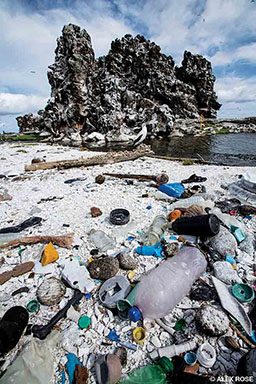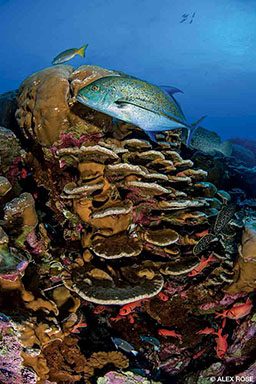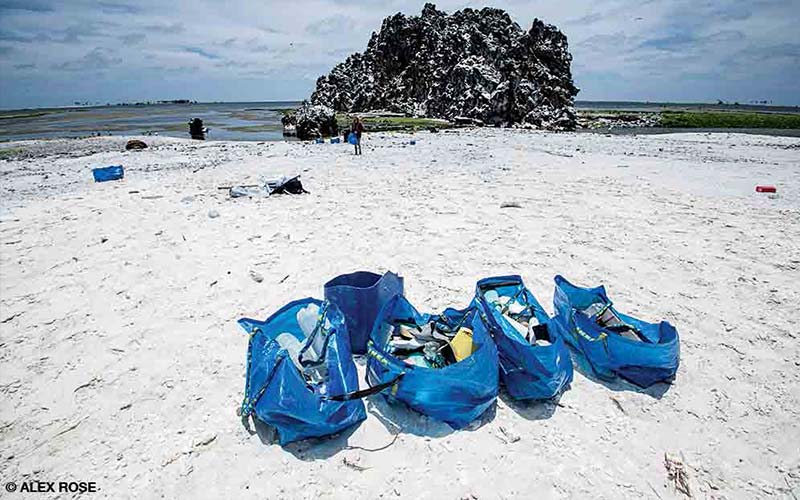Isolated takes on a new meaning when after three straight days of sailing you’re still more than 12 hours from your destination. This is the journey required to visit Clipperton, the most remote atoll in the world. The little dot in the Pacific is more than 750 miles away from Cabo San Lucas, our port of departure. It is almost 600 miles from the Revillagigedo Archipelago (Socorro Island), which is itself extremely remote by any normal standard.
Surrounded by coral reefs, Clipperton encloses a stagnant lagoon overgrown with algae on the surface and transected by a toxic layer of hydrogen sulfide at around 45 feet deep. I traveled to this atoll as part of the 2017 Big Migrations 2 Clipperton expedition team headed by Canadian explorers Michel Labrecque and Julie Ouimet. We carried Explorers Club Flag #93. For six days our team of 18 dived in Clipperton’s waters and explored the almost eight-mile ring of land that makes up the island. This was more time than most people get at Clipperton, but it still didn’t feel like nearly enough.

When I first backrolled into the ocean, I was immediately surprised by the warmth of the water — 87°F at the surface, according to my computer. We reached the reef at about 45 feet and were greeted by a large school of black durgon (triggerfish) that glided over huge, round coral heads. Coral boulders extended as far as the eye could see, all accompanied by groups of brilliant red soldierfish and highlighted by purple coralline algae around the bases. Shelves of Porites coral also dominated the landscape, providing shelter for juvenile groupers and perches for coral hawkfish. A school of grunts swam through my frame, soon followed by a train of trevally, and a curious leather bass hovered in front of my dome port.
We saw three fish species that are endemic to Clipperton: the Clipperton angelfish (Holacanthus limbaughi), the Clipperton gregory (Stegastes baldwini) and the Clipperton fanged blenny (Ophioblennius clippertonensis). Sixty minutes flew by, and before I knew it we were doing our safety stop in the blue warmth of Clipperton’s shallows.
Despite the atoll’s natural underwater beauty, I couldn’t help but notice the copious monofilament from longlines that were wrapped around the reef. We recovered almost two miles of line along with 18 hooks and 43 fasteners over the course of 17 dives as well as a huge ghost fishing net we dragged up from 50 feet. We collected as much as we could reasonably carry while underwater, but this represented only a tiny portion of what we saw. It quickly became evident that even out here in the middle of nowhere, marine ecosystems weren’t safe from human habits.
The same phenomenon was echoed on land, but on a far greater scale.

Clipperton looks like paradise at first glance. Turquoise waters crash onto a gleaming white beach of crushed coral punctuated by green palm trees. Hundreds of birds fly in a dramatic cloud-swept sky. But upon closer inspection a much more flawed landscape comes into focus. One that bears the ugly human fingerprint that seems to not leave any natural habitat on Earth untouched: plastic.
We live in the Anthropocene epoch (a term proposed but not yet officially accepted) — a period of geologic history defined and shaped by the activities of humankind — and plastic is our calling card. Each year we dump about 8 million tons of it into our world’s oceans, and if we stay on our current trajectory it is estimated there will be a larger volume of plastic in the ocean than fish by mid-century. These statistics hit home for me when I first stepped onto the most remote atoll in the world and could not move my feet without stepping on plastic. Humans have not thrown plastic refuse directly onto Clipperton Island, but by improperly disposing of it and indulging in the single-use plastic bonanza in which we find ourselves, we might as well have done exactly that.
The plastic on Clipperton went beyond plastic bottles and stray flip-flops. It ranged from refrigerators to razors, trinkets to toothbrushes, medical waste to microplastics. Every shape, size, color and variety of plastic is represented on this island, which has not been inhabited since before the plastic revolution began. If plastic plagues even Clipperton, an uninhabited island with no measurable visitation and surrounded by nothing but open ocean for hundreds of miles in every direction, it is clear that our lifestyle is in dire need of a sustainability makeover.
Plastic pollution is a huge problem, but it is presents an opportunity to make a monumental difference. Even the tiniest of actions when taken by many can create significant change. As people who actively appreciate and enjoy our world’s waters, divers can embrace the opportunity to set an example for those around us and thus expand our impact. Reject single-use plastics when possible, avoid using plastic bags, properly dispose of and recycle your garbage, buy a reusable coffee mug and water bottle, and refrain from using disposable utensils and straws. Purchasing glass or metal containers rather than their plastic counterparts can also help immensely.
Our addiction to plastic has gone far enough, and it is our responsibility as stewards of this blue planet to make educated lifestyle choices that limit our contribution to plastic pollution.

NOTE: All images and video from this expedition were acquired under permit #HC/1485/CAB/BSIRI/MG, authorized by the high commissioner of French Polynesia.
Explore More
| © Alert Diver — Q4 2017 |

